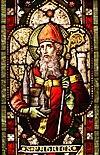| Saint Benignus of Armagh | |
|---|---|
 | |
| Born | 392 County Meath Ireland |
| Died | 467 |
| Venerated in | Roman Catholic Church, Eastern Orthodox Church |
| Feast | 9 November |

Benignus of Armagh (died 467) was the son of Sesenen, an Irish chieftain in the part of Ireland that is now called County Meath.
Life
He was baptised into the Christian faith by Saint Patrick, and became his favourite disciple and his coadjutor in the Diocese of Armagh around AD 450. His gentle disposition suggested the name Benen, which was Latinised as Benignus.
He followed his master in his travels and assisted him in his missionary labours, helping in the formation of choral services. His family may have belonged to the bardic order. From his musical achievements he was known as "Patrick's psalm-singer". As Benignus had been trained by Patrick in sacred learning from his youth and was well versed in the language and learning of his native land, he was appointed secretary to the Commission of Nine, which a few years before had been directed to compile the Brehon Laws.
Benignus is said to have contributed materials for the Psalter of Cashel, and the Book of Rights. He succeeded St. Patrick's nephew Sechnall as coadjutor and became the first rector of the Cathedral School of Armagh.
He was present at the synod that passed the canon recognising "the See Of the Apostle Peter" as the final court of appeals in difficult cases. This canon is to be found in the Book of Armagh. Benignus resigned his coadjutorship in 467 and died the same year. His feast is celebrated on 9 November.
In 433, Patrick clashed with King Laoghaire at Tara over religion. Legend reports that a trial by fire was proposed. A pagan druid and Benignus were tied inside a burning timber building, the former was reduced to ash while Benignus was untouched, at this turning point, Christian teaching was established.
Most authorities identified Patrick's psalm-singer with the Benignus who founded Kilbannon, near Tuam. However, Tirechán's collections in the Book of Armagh states that Benignus of Kilbannon was the son of Lugni of Connaught. Benignus of Kilbannon had a famous monastery, where Jarlath was educated, and he presided over Drumlease. His sister Mathona served as abbess of Tawney, in Tirerrill.
In Cavan, he established a monastery on Drom Benen (hill of Benan), today's Drumbannon. Other monasteries are in cill benen (church of Benan), today's Kilbonane, West Cork.
See also
References
- Farmer, David (2004). Oxford Dictionary of Saints. Oxford University Press. p. 53. ISBN 978-0-19-860949-0.
- ^ Grattan-Flood, William. "St. Benignus." The Catholic Encyclopedia. Vol. 2. New York: Robert Appleton Company, 1907. 30 Jan. 2013
- ^ Healy, John. "The School of Armagh." The Catholic Encyclopedia. Vol. 1. New York: Robert Appleton Company, 1907. 9 May 2013
- 'The Legend of Tara' by Elizabeth Hickey 1969
Further reading
 Webb, Alfred (1878). "Saint Benin". A Compendium of Irish Biography. Dublin: M. H. Gill & son.
Webb, Alfred (1878). "Saint Benin". A Compendium of Irish Biography. Dublin: M. H. Gill & son.- Dumville, David N. "Auxilius, Iserninus, Secundinus and Benignus." In Saint Patrick, AD 493-1993, ed. by David N. Dumville and Lesley Abrams. Studies in Celtic history 13. Woodbridge: Boydell, 1993. pp. 89–105. ISBN 0-85115-332-1.
| Archbishops of Armagh | |
|---|---|
| Primate of All Ireland · Catholic Church in Ireland · Archdiocese of Armagh | |
| 5th–8th centuries |
|
| Abbots 8th–12th centuries |
|
| Bishops 8th–12th centuries |
|
| Archbishops 12th–16th centuries |
|
| Archbishops 16th–21st centuries |
|
| Italics indicate a person who was elected but not consecrated. | |
